常用时间介词用法
时间前面的介词用法

时间名词前所用介词的速记歌年月周前要用in,日子前面却不行。
遇到几号要用on,上午下午又是in。
要说某日上下午,用on换in才能行。
午夜黄昏须用at,黎明用它也不错。
at也用在明分前,说“差”可要用上to,说“过”只可使用past,多说多练牢牢记,莫让岁月空蹉跎。
下面就时间概念的介词用法做一简要介绍和比较。
1.at表示时间概念的某一个点。
(在某时刻、时间、阶段等)。
at 1:00(dawn,midnight,noon)在一点钟(黎明、午夜、中午)These are our chief tasks at the present stage.这些就是我们现阶段的主要任务。
2.on1)表示具体日期。
They arrived in shanghai on May 25.他们在五月二十五日到达上海。
注:(1)关于"在周末"的几种表示法:at(on)the weekend 在周末---特指at(on)weekends 在周末---泛指over the weekend 在整个周末during the weekend 在周末期间(2)在圣诞节,应说"at Christmas?而不说"on Christmas?2)在(刚……)的时候。
On reaching the city he called up his parents.一到城里他就给父母打了一个电话。
3.in1)表示"时段"、"时期",在多数情况下可以和during互换,前者强调对比,后者强调持续。
in(during)1988(December,the 20th century)在一九八八年(十二月、二十世纪)I returned to Beijing in the middle of June.我是六月中回北京的。
但如果表示"在某项活动的期间",则只能用during。
介词的含义及用法
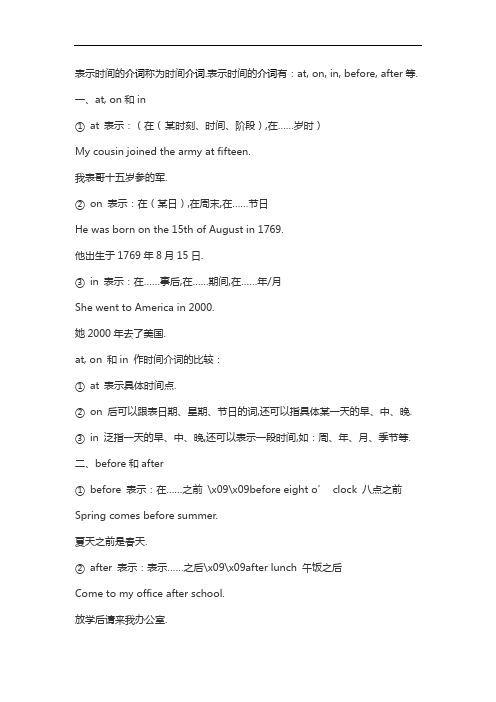
表示时间的介词称为时间介词.表示时间的介词有:at, on, in, before, after等.一、at, on和in①at 表示:(在(某时刻、时间、阶段),在……岁时)My cousin joined the army at fifteen.我表哥十五岁参的军.②on 表示:在(某日),在周末,在……节日He was born on the 15th of August in 1769.他出生于1769年8月15日.③in 表示:在……事后,在……期间,在……年/月She went to America in 2000.她2000年去了美国.at, on 和in 作时间介词的比较:①at 表示具体时间点.②on 后可以跟表日期、星期、节日的词,还可以指具体某一天的早、中、晚.③in 泛指一天的早、中、晚,还可以表示一段时间,如:周、年、月、季节等.二、before和after①before 表示:在……之前\x09\x09before eight o’clock 八点之前Spring comes before summer.夏天之前是春天.②after 表示:表示……之后\x09\x09after lunch 午饭之后Come to my office after school.放学后请来我办公室.表示做某事的方法、手段的介词有by, with, in, at, on.一、byby表示:用,以,靠,通过……方式.by表示手段时后接动作或制作方式.“by + 交通工具”表示交通方式.by bike 骑车\x09by bus 坐公车\x09by taxi 搭出租by train 坐火车\x09by ship 乘船\x09by air 坐飞机Linda usually goes to work by subway.琳达通常做地铁上班.She makes a living by teaching.她考教书谋生.二、withwith 表示:用,以.with表示手段时,后接工具、材料或具体内容.write with a pen 用钢笔写eat with knife and fork 用刀叉吃see with one’s eyes 用眼睛看I killed the fly with a swatter.我用苍蝇拍打死那只苍蝇.She cut the cake with a knife.她用刀切开了蛋糕.三、inin 表示:用,以.in表示用某种方式,如:颜色、笔墨、语言、声音、服饰等.speak in English 用英语说talk in a high voice 高声说话I wrote a letter in ink.我用钢笔写了一封信.Try to express yourself in English.试着用英语表达一下.表示空间的介词有:at, in, on, over, above, under, below 等表示静态位置的介词和from, to, up, down, through, across 等表示动态方向的介词.一、at, on 和in①at 表示:(地点、位置)在……②on 表示:(位置)在……上面③in 表示:(地点、位置或空间)在……里,在……中,在……上Her fans have arrived at the airport.她的影迷已经到达了机场.Look at the picture at the top of the page.请看以下这一项上面的图片.Is my pen on the desk or in the desk?我的钢笔是在桌子上还是在抽屉里呢?Some kids are playing in the yard and others are playing in the room. 有些孩子在院子里玩,其他则在房间里玩.at,on 和in 作空间介词的比较①at用于表示一个较小的场合,这个地点被当作一个点来看待.②on 表示在某一平面或线上,强调与某物体有接触.③in 表示在较大的地方,在某立体空间或平面范围之内.二、about 和around①over 二者都表示:在……周围/各处,围绕.但②above about强调无方向.We walked about in the town.我们在城里到处游逛.Dudu is running around the fence.嘟嘟在绕着篱笆跑.Let’s plant trees around the house.让我们在房子周围栽上树.三、over 和above①under 表示:在……正上方,越过②above 表示:在……上方I saw a wood bridge over the river.我看见河上有座木桥.Look! Some birds are flying above the clouds.看!一些鸟儿在云朵上飞翔.over和above作空间介词的比较①over强调在某人或某物的正上方,而且两物体表面没有接触.②above 强调位置上某物体的上方,并不一定是正上方,而且两物体表面也没有接触.四、under 和below①under 表示:在……的正下方②below 表示:在……下方Please read the words below the picture.请读图片下面的文字.Look! A big mouse hides under the armchair.看!一只大老鼠躲在扶手椅下面.under 和below 作空间介词的比较①under 强调在某物的下方,完全覆盖两物体表面可以接触也可以不接触.②below 强调位置低于某参照物,但并不一定是正下方.五、between 和among①between 表示:(位置、时间、数量等)在……之间(两者之间)②among 表示:在……中间(三者或三者以上之间)I often fly between Beijing and Shanghai.我经常在北京和上海之间飞来飞去.Come here between eight and nine o’clock.请把点到九点之间过来.Susan is among the crowd.苏珊是人群当中.六、into 和out of①into 表示:进来②out of 表示:出去Get out of the room.从房间里出去!Bob walked into the room.鲍勃走进房间.He is working in the office.她在办公室里工作.七、behind 和in front of①behind 表示:在……后面②in front of 表示:在……前面There is a fountain in the front of the park.公园的前面有一个喷泉.Susan sits in front of me and Dudu sits behind me. 苏珊坐在我前面,嘟嘟坐在我后面.八、up 和down①up 表示:往上,向……顶上②down 表示:往下,沿着……往下The monkey is climbing up the tree.猴子正在往树上爬.Tears ran down her face.眼泪从她的脸上流了下来.九、across 和through①across 表示:穿过,跨过②through表示:穿过,通过There is a bridge across the river there.那儿有座桥横跨在河上.A train is running through the tunnel.一列火车正从隧道中穿过.十、by 和near①by 表示:在……旁边②near 表示:在……附近Come over here and stand by me.过来站在我旁边吧.We are planning to camp by the lake.我们打算到湖边露营.There are some big apple trees near the house. 房子附近有一些大苹果树.The new hospital is near our school.新医院里我们学校不远.十一、其他空间介词①along 表示:沿着,顺着②to 表示:到……,去……,向……Let’s walk along the street.让我们沿着街散散步.We drove along the freeway.我们驱车沿着高数公路行驶.The child pointed to the polar star.那孩子指着北极星.I’m going to the bakery.我想要去那家糕饼店.*第一个to表示“指”的方向、目标.第二个to表示到达的目的地.除了按上面介绍表示时间关系、空间关系、方式、手段等的介词外,还有一些重要的介词:一、of 的用法①of 表示:……的(表示所属、所有关系)a cover of this book这本书的封皮a friend of my parents我父母的一个朋友②of 表示:……之中的(表示部分)some boys of the team小组里的几个男生the end of the story故事的结尾Two students of our class joined in the match.我们班里的两个同学参加了这场比赛.All of us approved his plan.我们全都赞成他的计划.③of 表示:……份/量的,……的种类的(表示量、种类)a drop of water一滴水a pair of shoes一双鞋I want two cups of coffee.我要两杯咖啡.二、with 的用法①with 表示:具有,有……的,随身带着It is a dog with black spots.它是一只长着黑色斑点的狗.Take an umbrella with you.带把雨伞吧!②with表示:和……一起,同……一起,偕同I went to Disneyland with my mother.我和妈妈一起去了迪斯尼乐园.Jane likes to play with Mimi.简喜欢和咪咪玩耍.③with 表示:随着……The wine improves with age.这种酒越陈越香.I get up with the sun every day.我每天日出就起床.三、for 的用法①for 表示:为了……(表示目的、用途、利益)Give me a knife for cutting bread.给我一把切面包的刀子.I’ve found it for you.我已经为你找到了它.What can I do for you?我能为你做些什么吗?②for 表示:一段距离或时间He has run for a mile.他跑了一英里.I’ve studied in Beijing for three years.我在北京学习三年了.Please bake the cake for 40 minutes.请将蛋糕烤四十分钟.③for 表示:因为,由于(表示原因)Thank you for your help.谢谢你的帮助.Andy jumped for joy at the good news.安迪听到这个消息高兴的跳了起来.We could hardly see for the mist.由于大雾,我们几乎看不见了.四、like 的用法①like表示:像……(一样),似……(一样)They are like brothers and sisters.他们情同手足.②like 表示:是什么样子,怎样Andy looks just like his father.安迪和他爸爸像极了.五、from 的用法①from 表示:(时间或场所)从……,自……We work from Monday to Friday.我们周一到周五上班.Charlie will fly from New York to London.查理要从纽约飞往伦敦.The cat jumped down from the top of the wall. 猫从墙头跳了下来.②from 表示(两地的距离)离The nearest hospital is 10 miles from my house.最近的医院离我家十英里远.We live about 5 kilometers from Boston.我们住在离波士顿约五公里的地方.③from 表示:出自……,来自……Did you have a (phone) call from him?你接到他的电话了吗?Where are you from?你来自哪里?Susan got a letter from her aunt.苏珊收到一封她姨妈的来信.六、at, about, to 和in 的其他用法①at 表示:对着……, 朝着……,向……(表示方向,目标)He threw a bone at the dog.他用一块骨头砸狗.Please look at the blackboard.请看黑板.Jack shot at the deer but missed.杰克朝鹿开了一枪,但是没有打中.②about 表示:关于……,涉及……He told me a story about ghosts.他给我讲了一个鬼故事.Don’t worry about me.不要担心我.They are talking about English learning. 他们在谈论英语学习.③to 表示:对于,给,向(表示对象)Jane is always very kind to others.简总是对别人很友善.Please send some food to them.请给他们送些食品去.Have you told all the news to John?你把全部的消息都告诉约翰了吗?④in 表示:穿着,戴着Who is the man in black?那穿黑色衣服的人是谁?Tom is in a purple hat.汤姆戴着紫色帽子.The girl in uniform is Mary.穿校服的那个女孩是玛丽.。
常用介词用法及区别整理

1、表示时间的介词(1)at:用于表示时刻,时间的某一点,年龄,就餐时间at noon在午时at night在夜间at present目前(2)on:用于星期几,某天,某一天的上午、下午、晚上(指具体的某一天时,一律用,也可以说是上午、下午、晚上有修饰的一律用ON),特定的时间、含day的节日on Sunday 在星期天on Sunday morning 在星期天的上午on March 8 在3月8日(3)in:用于表示周、月、季节、年、泛指上午、下午、晚上。
in 1999 在1999年in November 在11月份in summer 在夏季in the afternoon在下午in + 时间段:过……后(内),用于将来时I think he will be back in an hour.我想他一小时后就会回来。
I heard that she would be back in a month.我听说她一个月后回来的。
(4)after:在……之后after that ,no one should ever kill a seagull .从那时起,任何人不得捕杀海鸥。
after + 时间段:在……之后,用于过去时。
.(5)before:在……之前Wei hua got up before 7 o’cl ock this morning .今天早晨,魏华在7点之前起床了。
He won’t come back before five.(6)by:到……为止,截止(到)……By the time i arrived ,she had already gone .在我到达之前,她已经走了。
The work must be finished by Friday.We had three meetings by last Friday.(7)for:达……之久(表示过了多少时间),可以和一般现在时,过去时,将来时连用,但是经常和完成时连用。
时间介词的用法总结
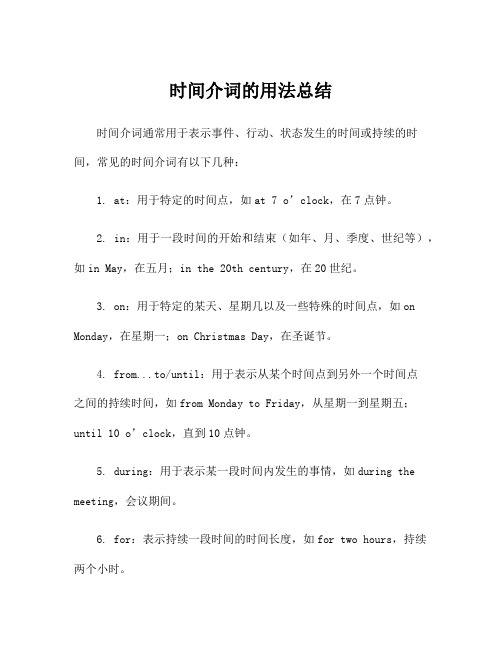
时间介词的用法总结
时间介词通常用于表示事件、行动、状态发生的时间或持续的时间,常见的时间介词有以下几种:
1. at:用于特定的时间点,如at 7 o’clock,在7点钟。
2. in:用于一段时间的开始和结束(如年、月、季度、世纪等),如in May,在五月;in the 20th century,在20世纪。
3. on:用于特定的某天、星期几以及一些特殊的时间点,如on Monday,在星期一;on Christmas Day,在圣诞节。
4. from...to/until:用于表示从某个时间点到另外一个时间点
之间的持续时间,如from Monday to Friday,从星期一到星期五;until 10 o’clock,直到10点钟。
5. during:用于表示某一段时间内发生的事情,如during the meeting,会议期间。
6. for:表示持续一段时间的时间长度,如for two hours,持续两个小时。
需要注意的是,有些时间介词在不同的情况下有着不同的含义,例如at在表示“在某个时间”的同时也可以表示“在某个地点”;in 在表示时间段的同时也可以表示“在某个地点”等等。
另外,虽然时间介词的用法比较固定,但还是要注意具体的语境和句子结构,尽可能准确和恰当地使用时间介词。
介词on,in,at的用法及例句
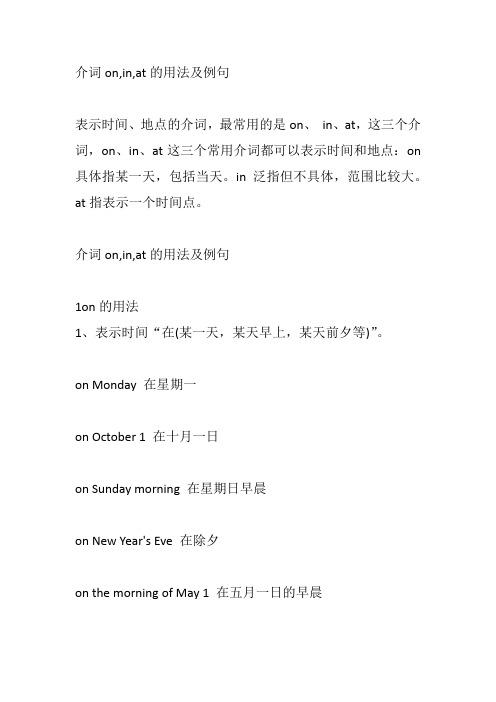
介词on,in,at的用法及例句表示时间、地点的介词,最常用的是on、in、at,这三个介词,on、in、at这三个常用介词都可以表示时间和地点:on 具体指某一天,包括当天。
in泛指但不具体,范围比较大。
at指表示一个时间点。
介词on,in,at的用法及例句1on的用法1、表示时间“在(某一天,某天早上,某天前夕等)”。
on Monday 在星期一on October 1 在十月一日on Sunday morning 在星期日早晨on New Year's Eve 在除夕on the morning of May 1 在五月一日的早晨He went home on Monday last week.他在上星期一回家了。
2、表示位置“在...上”(与物体接触)There is a map of world on the wall.墙上有一幅世界地图3、表示“关于”(表示关系)。
We will have a talk on the history of the Party this afternoon.今天下午我们有关于党史的报告。
What about your idea on the subject?关于这个问题你有什么看法?4、引申意义,表示“从事...”“处于...情况中”。
They are on holiday.他们在度假。
2in的用法1、表示时间(年、月、季节、早晨、下午、晚间等) in 1976 在1976年in October 在十月in spring 在春天in the morning/afternoon/evening 在早上/下午/晚上I will come in a week.我一周后回来。
2、表示地点、场所。
The bullet wounded me in the leg.子弹打伤了我的腿。
3、表示“穿着、戴着(衣服、帽子等)”。
The girl in red is Li Ming's sister.穿红衣服的女孩是李明的妹妹。
介词的使用方法口诀
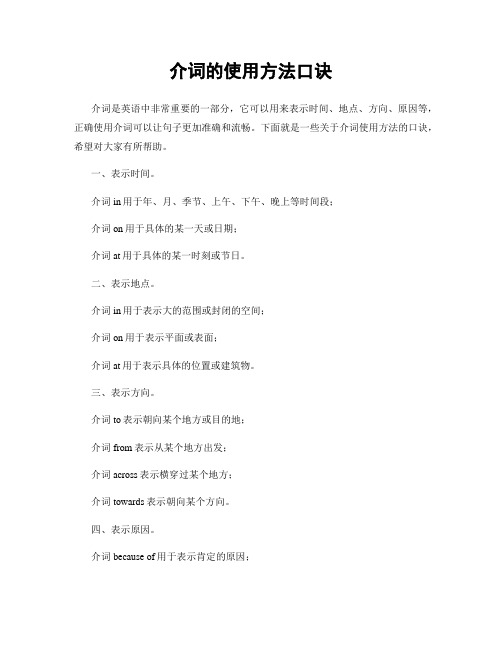
介词的使用方法口诀介词是英语中非常重要的一部分,它可以用来表示时间、地点、方向、原因等,正确使用介词可以让句子更加准确和流畅。
下面就是一些关于介词使用方法的口诀,希望对大家有所帮助。
一、表示时间。
介词in用于年、月、季节、上午、下午、晚上等时间段;介词on用于具体的某一天或日期;介词at用于具体的某一时刻或节日。
二、表示地点。
介词in用于表示大的范围或封闭的空间;介词on用于表示平面或表面;介词at用于表示具体的位置或建筑物。
三、表示方向。
介词to表示朝向某个地方或目的地;介词from表示从某个地方出发;介词across表示横穿过某个地方;介词towards表示朝向某个方向。
四、表示原因。
介词because of用于表示肯定的原因;介词due to用于表示中性的原因;介词owing to用于表示正式的原因;介词thanks to用于表示积极的原因。
五、其他常用介词。
介词by表示通过某种方式或工具;介词with表示伴随或使用某物;介词for表示为了某种目的或代表某人。
六、特殊用法。
介词in、on、at在特定搭配中有特殊用法,需要根据具体情况进行记忆和理解。
七、总结。
介词的使用方法口诀并非一成不变,需要根据具体语境进行灵活运用。
通过大量的阅读和实践,逐渐掌握介词的用法是非常重要的。
以上就是介词的使用方法口诀,希望对大家有所帮助。
在学习英语的过程中,多多积累、多多练习,相信大家一定能够掌握好介词的使用方法,写出更加地道和流畅的英语句子。
介词在时间的用法归纳
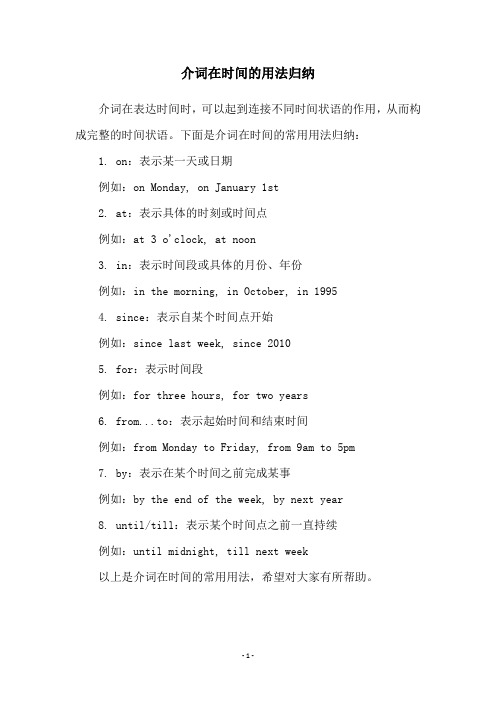
介词在时间的用法归纳
介词在表达时间时,可以起到连接不同时间状语的作用,从而构成完整的时间状语。
下面是介词在时间的常用用法归纳:
1. on:表示某一天或日期
例如:on Monday, on January 1st
2. at:表示具体的时刻或时间点
例如:at 3 o'clock, at noon
3. in:表示时间段或具体的月份、年份
例如:in the morning, in October, in 1995
4. since:表示自某个时间点开始
例如:since last week, since 2010
5. for:表示时间段
例如:for three hours, for two years
6. from...to:表示起始时间和结束时间
例如:from Monday to Friday, from 9am to 5pm
7. by:表示在某个时间之前完成某事
例如:by the end of the week, by next year
8. until/till:表示某个时间点之前一直持续
例如:until midnight, till next week
以上是介词在时间的常用用法,希望对大家有所帮助。
- 1 -。
40个英语介词用法总结
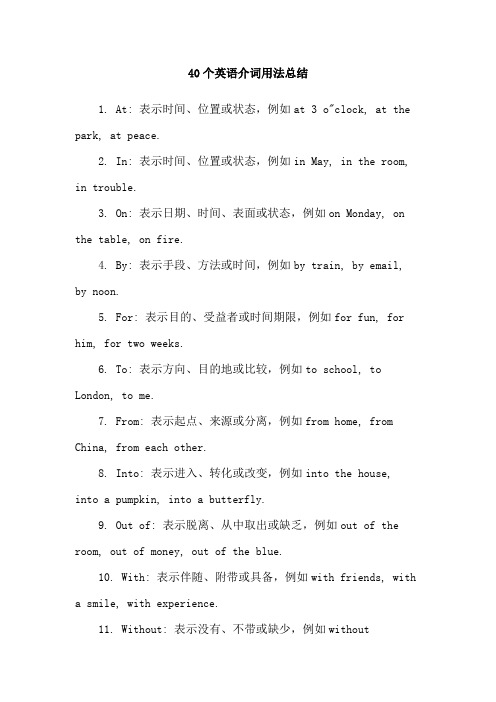
40个英语介词用法总结1. At: 表示时间、位置或状态,例如at 3 o"clock, at the park, at peace.2. In: 表示时间、位置或状态,例如in May, in the room, in trouble.3. On: 表示日期、时间、表面或状态,例如on Monday, on the table, on fire.4. By: 表示手段、方法或时间,例如by train, by email, by noon.5. For: 表示目的、受益者或时间期限,例如for fun, for him, for two weeks.6. To: 表示方向、目的地或比较,例如to school, to London, to me.7. From: 表示起点、来源或分离,例如from home, from China, from each other.8. Into: 表示进入、转化或改变,例如into the house,into a pumpkin, into a butterfly.9. Out of: 表示脱离、从中取出或缺乏,例如out of the room, out of money, out of the blue.10. With: 表示伴随、附带或具备,例如with friends, witha smile, with experience.11. Without: 表示没有、不带或缺少,例如withoutpermission, without shoes, without doubt.12. Over: 表示覆盖、超过或结束,例如over the roof, over the limit, over and done with.13. Under: 表示在下面、被支配或不足,例如under the table, under his control, under budget.14. About: 表示关于、大约或忙于,例如about the movie, about 10 dollars, about to leave.15. Above: 表示在上面、高于或超过,例如above the clouds, above average, above suspicion.16. Below: 表示在下面、低于或不足,例如below the surface, below freezing, below par.17. Across: 表示横穿、相交或涉及,例如across the street, across the board, across his mind.18. Beyond: 表示超出、远离或除了,例如beyond repair, beyond belief, beyond her control.19. Around: 表示周围、附近或环绕,例如around the corner, around the clock, around the world.20. Before: 表示以前、在前面或比较,例如before noon, before the house, before his time.21. Behind: 表示在后面、落后或背后,例如behind the house, behind schedule, behind the scenes.22. Beside: 表示在旁边、与...相比或附加,例如besidethe river, beside myself, beside the point.23. Inside: 表示内部、在里面或被包含,例如inside the box, inside the building, inside information.24. Outside: 表示外部、在外面或超出,例如outside the house, outside the box, outside the norm.25. Through: 表示穿过、经过或完成,例如through the door, through the park, through with it.26. Throughout: 表示遍布、贯穿或在整个期间,例如throughout the city, throughout history, throughout the day.27. Towards: 表示朝向、对于或接近,例如towards the sun, towards him, towards the end.28. Against: 表示反对、抵抗或紧挨着,例如against the law, against the current, against the wall.29. Among: 表示在...之中、相互之间或被分配到,例如among friends, among the stars, among the winners.30. Between: 表示在两者之间、在中间或相互之间,例如between two trees, between classes, between you and me.31. Within: 表示在内部、在范围之内或在规定时间内,例如within the house, within the budget, within a week.32. Without: 表示在外面、没有或不用,例如without the room, without a doubt, without further ado.33. Beneath: 表示在下面、低于或不足,例如beneath the surface, beneath his dignity, beneath contempt.34. Beside: 表示在旁边、与...相比或附加,例如beside the river, beside myself, beside the point.35. Into: 表示进入、转化或改变,例如into the house, into a pumpkin, into a butterfly.36. Upon: 表示在...之上、一旦发生或基于,例如upon the hill, upon arrival, upon further consideration.37. With: 表示伴随、附带或具备,例如with friends, witha smile, with experience.38. Within: 表示在内部、在范围之内或在规定时间内,例如within the house, within the budget, within a week.39. Without: 表示没有、不带或缺少,例如without permission, without shoes, without doubt.40. Beneath: 表示在下面、低于或不足,例如beneath the surface, beneath his dignity, beneath contempt.。
英语中表示时间的介词

5. I remember Susan left _____a very cold morning of January.
A. in
6. We don’t go to school _____Sundays.
A. on
B. in C. at
D. with
7. Mr. Smith taught English in China ______1997.
on June 1st ,on the morning of July 2 3)morning, afternoon, evening, night, day前有描绘性修饰语 时与on连用;
on that evening, on a cold night, on that day 4)表示周年纪念日;
练习:
1. The story happened ______the evening of August 2.
常用介词的用法

常用介词的用法介词可以用来表示时间、空间、方位、手段等含义,其具体用法如下:表示时间表示时间的介词主要有at, on,in, during,for, since,after, before 等.①atat 表示在某一具体时刻,或把某一段时间看作某一时刻时也可用at。
在节假日也常用at。
at 7:30 在七点半at noon 在正午at that time 在那时at first 首先at the end of 在……最后at the beginning of 在……开始时at the moment 当时、这时at the present (time) 目前at Christmas 在圣诞节at midnight 在半夜at breakfast time 在吃早饭时at the beginning 开始at present 目前②on当表示在具体的某一天,某一天的早晨、中午或晚上时常用介词on;对某一天或某一天的早晨、中午或晚上进行详细描述时也用on。
on Monday 在星期一on May the first 在五月一日on a rainy day 在雨天on Monday morning 在星期一早晨on the following evening 在第二天傍晚on the morning of April the first 在四月一日上午on the following day 在第二天on New Year’s Day 在元旦on a cold day 在寒冷的一天on the weekend 在周末③in当所指的时间比一天更长或更短时用介词in. in还可表示在将来,用在从现在算起的一段时间之后.in the evening 在傍晚in spring 在春季in the 21st century 在二十一世纪in the 1990’s 在二十世纪90年代in my school days 在我上学期间in August 在八月in 2004 在2004年in one's life 在一生中in the future 在将来in the daytime 在白天④duringduring 除了具有in表示时间段的功能之外,还可指在某一项活动的过程中。
介词的用法大全

介词的用法一.表示时间日期的介词1. at:主要表示方向、场所、时间的某一点at the corner of the street,at dinner,at sixty miles an hour,be sold at three yuan a dozen,come at us固定搭配: at one time, at the beginning of, at the post office, at the airport, at the weekend,at the age of 25,at the same time, at present,at any time,表示原因,表示“见/闻……而”。
at the newsat 主要表示时间点表示特定的时间 at night a.m. 在九点钟表示不确定的时间 at night, at that time, at Christmas 在圣诞期间当天 on表示年龄段 at the age of eight 在 8 岁2. in:表示场所、时间与期限、状况、方向。
主要用来表示较长的时间单位,如月份、季节、年份等in the 1990s in the late 19th century形成“in+时段名词”的词组或固定搭配in those days,in the daytime,in a short while,in no time,in time.in 主要表示时间段一般指相对较长的时间段里 in the morning, in spring, in the past ten years在…时间之后,用于将来时 He will be back in a month.介词 in 在短语或句型中的省略:1) 某些形容词/过去分词后接 v-ing 形式时,v-ing 形式前的介词 in 可以省略。
be busy (in) doing be engaged (in) doing (忙于……)2) 某些动词如 busy 等,常与反身代词连用,其后的 in 也可以省略。
英语中常用介词的基本用法
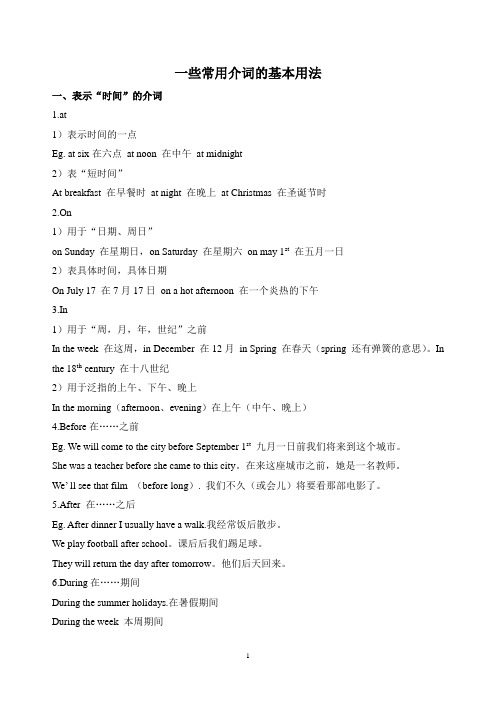
一些常用介词的基本用法一、表示“时间”的介词1.at1)表示时间的一点Eg. at six在六点at noon 在中午at midnight2)表“短时间”At breakfast 在早餐时at night 在晚上at Christmas 在圣诞节时2.On1)用于“日期、周日”on Sunday 在星期日,on Saturday 在星期六on may 1st在五月一日2)表具体时间,具体日期On July 17 在7月17日on a hot afternoon 在一个炎热的下午3.In1)用于“周,月,年,世纪”之前In the week 在这周,in December 在12月in Spring 在春天(spring 还有弹簧的意思)。
In the 18th century 在十八世纪2)用于泛指的上午、下午、晚上In the morning(afternoon、evening)在上午(中午、晚上)4.Before在……之前Eg. We will come to the city before September 1st九月一日前我们将来到这个城市。
She was a teacher before she came to this city。
在来这座城市之前,她是一名教师。
We’ ll see that film (before long). 我们不久(或会儿)将要看那部电影了。
5.After 在……之后Eg. After dinner I usually have a walk.我经常饭后散步。
We play football after school。
课后后我们踢足球。
They will return the day after tomorrow。
他们后天回来。
6.During在……期间During the summer holidays.在暑假期间During the week 本周期间During the last few years在最近几年。
时间介词at的用法
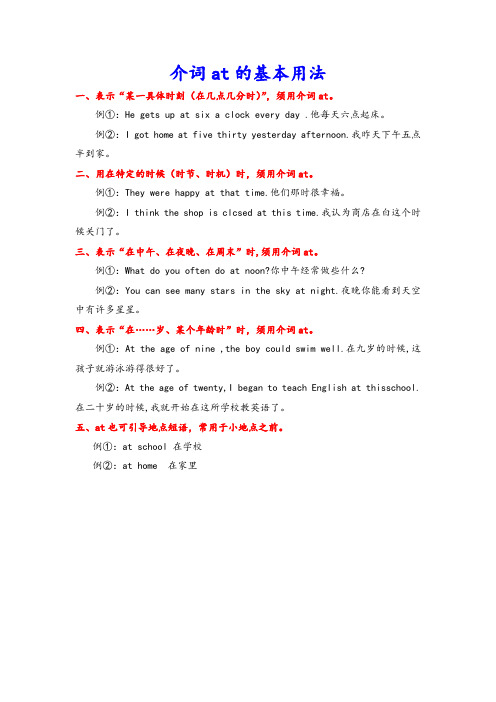
介词at的基本用法
一、表示“某一具体时刻(在几点几分时)”,须用介词at。
例①:He gets up at six a clock every day .他每天六点起床。
例②:I got home at five thirty yesterday afternoon.我昨天下午五点半到家。
二、用在特定的时候(时节、时机)时,须用介词at。
例①:They were happy at that time.他们那时很幸福。
例②:I think the shop is clcsed at this time.我认为商店在白这个时候关门了。
三、表示“在中午、在夜晚、在周末”时,须用介词at。
例①:What do you often do at noon?你中午经常做些什么?
例②:You can see many stars in the sky at night.夜晚你能看到天空中有许多星星。
四、表示“在……岁、某个年龄时”时,须用介词at。
例①:At the age of nine ,the boy could swim well.在九岁的时候,这孩子就游泳游得很好了。
例②:At the age of twenty,I began to teach English at thisschool.在二十岁的时候,我就开始在这所学校教英语了。
五、at也可引导地点短语,常用于小地点之前。
例①:at school 在学校
例②:at home 在家里。
时间介词(at, in ,on) 的用法

时间介词(at, in ,on) 的用法1. at(1)时间的一点、时刻等。
如:They came home at seven o’clock.(at night, at noon, at midnight, at ten o’clock, at daybreak, at dawn). (2)后面接表示岁数的词。
Children in China start school at 6 years old.(3)较短暂的一段时间。
可指某个节日或被认为是一年中标志大事的日子。
如: He went home at Christmas (at New Year, at the Spring Festival).2. in(1)在某个较长的时间(如世纪、朝代、年、月、季节以及泛指的上午、下午或傍晚等)内。
如:in 2004, in March, in spring, in the morning, in the evening, etc (2)在一段时间之后,常用于将来时。
He will arrive in two hours.These products will be produced in a month.3. on(1)具体的时日和一个特定的时间,如某日、某节日、星期几等。
如:On Christmas Day(On May 4th), there will be a celebration. (2)在某个特定的早晨、下午或晚上。
如: He arrived at 10 o’clock on the night of the 5th. (3)准时,按时。
如:If the train should be on time, I should reach home before dark.表示频率的副词用法详解一、常见的频率副词always,usually,often,sometimes, seldom,never.1) always表示的频率为100%,意思是"总是、一直、始终"。
in和on的时间用法
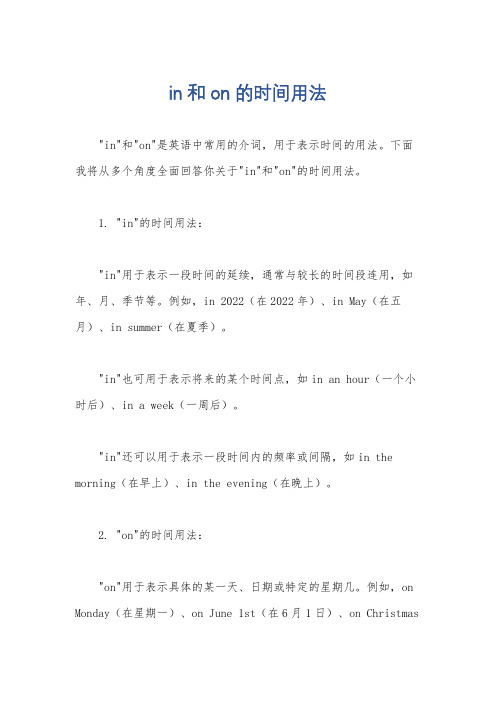
in和on的时间用法"in"和"on"是英语中常用的介词,用于表示时间的用法。
下面我将从多个角度全面回答你关于"in"和"on"的时间用法。
1. "in"的时间用法:"in"用于表示一段时间的延续,通常与较长的时间段连用,如年、月、季节等。
例如,in 2022(在2022年)、in May(在五月)、in summer(在夏季)。
"in"也可用于表示将来的某个时间点,如in an hour(一个小时后)、in a week(一周后)。
"in"还可以用于表示一段时间内的频率或间隔,如in the morning(在早上)、in the evening(在晚上)。
2. "on"的时间用法:"on"用于表示具体的某一天、日期或特定的星期几。
例如,on Monday(在星期一)、on June 1st(在6月1日)、on ChristmasDay(在圣诞节)。
"on"也可用于表示特定的节日或纪念日,如on New Year'sDay(在元旦)、on Valentine's Day(在情人节)。
"on"还可以用于表示具体的某个时刻或时间点,如on the weekend(在周末)、on the morning of June 1st(在6月1日的早上)。
需要注意的是,有些情况下"in"和"on"可以互换使用,但有些情况下只能使用其中之一。
例如,我们可以说"in the morning"或"on Monday morning",但不能说"on the morning"或"in Monday morning"。
常见介词的用法
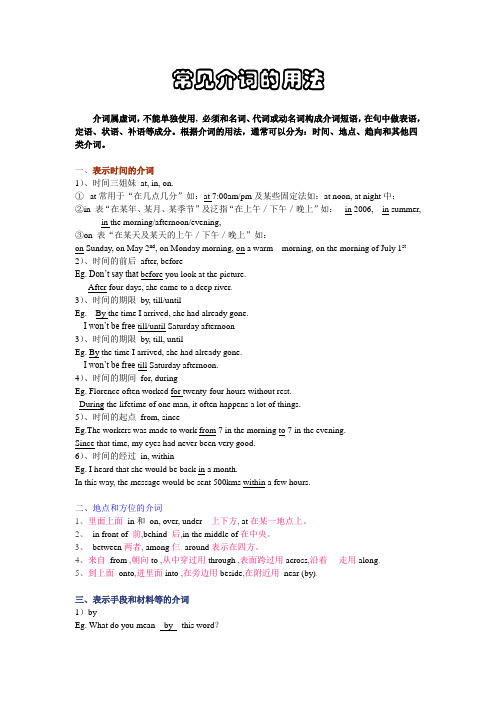
常见介词的用法介词属虚词,不能单独使用, 必须和名词、代词或动名词构成介词短语,在句中做表语,定语、状语、补语等成分。
根据介词的用法,通常可以分为:时间、地点、趋向和其他四类介词。
一、表示时间的介词1)、时间三姐妹at, in, on.①at常用于“在几点几分”如:at 7:00am/pm及某些固定法如:at noon, at night中;②in 表“在某年、某月、某季节”及泛指“在上午/下午/晚上”如:in 2006, in summer,in the morning/afternoon/evening,③on 表“在某天及某天的上午/下午/晚上”如:on Sunday, on May 2nd, on Monday morning, on a warm morning, on the morning of July 1st 2)、时间的前后after, beforeEg. Don’t say that before you look at the picture.After four days, she came to a deep river.3)、时间的期限by, till/untilEg. By the time I arrived, she had already gone.I won’t be free till/until Saturday afternoon3)、时间的期限by, till, untilEg. By the time I arrived, she had already gone.I won’t be free till Saturday afternoon.4)、时间的期间for, duringEg. Florence often worked for twenty-four hours without rest.During the lifetime of one man, it often happens a lot of things.5)、时间的起点from, sinceEg.The workers was made to work from 7 in the morning to 7 in the evening.Since that time, my eyes had never been very good.6)、时间的经过in, withinEg. I heard that she would be back in a month.In this way, the message would be sent 500kms within a few hours.二、地点和方位的介词1、里面上面in和on, over, under上下方, at在某一地点上。
常见介词的用法
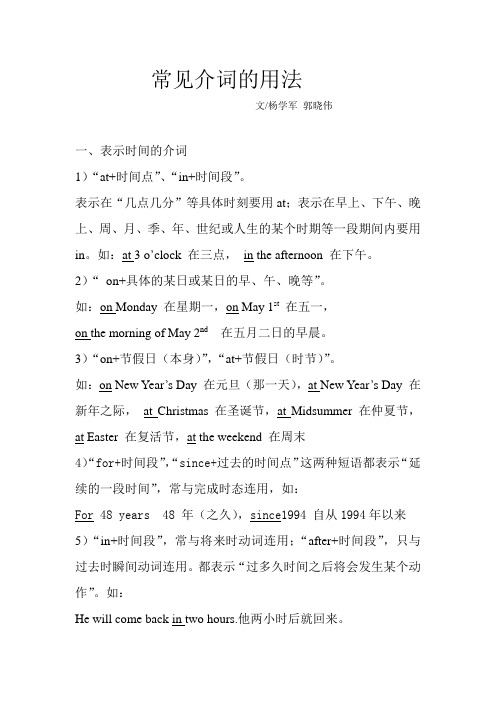
常见介词的用法文/杨学军郭晓伟一、表示时间的介词1)“at+时间点”、“in+时间段”。
表示在“几点几分”等具体时刻要用at;表示在早上、下午、晚上、周、月、季、年、世纪或人生的某个时期等一段期间内要用in。
如:at 3 o’clock 在三点,in the afternoon 在下午。
2)“on+具体的某日或某日的早、午、晚等”。
如:on Monday 在星期一,on May 1st在五一,on the morning of May 2nd在五月二日的早晨。
3)“on+节假日(本身)”,“at+节假日(时节)”。
如:on New Year’s Day 在元旦(那一天),at New Year’s Day 在新年之际,at Christmas 在圣诞节,at Midsummer 在仲夏节,at Easter 在复活节,at the weekend 在周末4)“for+时间段”,“since+过去的时间点”这两种短语都表示“延续的一段时间”,常与完成时态连用,如:For 48 years 48 年(之久),since1994 自从1994年以来5)“in+时间段”,常与将来时动词连用;“after+时间段”,只与过去时瞬间动词连用。
都表示“过多久时间之后将会发生某个动作”。
如:He will come back in two hours.他两小时后就回来。
He came back after two hours.俩个小时后回来了。
二、表示地点、范围、趋向的介词。
1)“at+点”,“on+面”,“in+体”。
如:He stood at the door with a picture on it,looking in through a hole in the door.一个陌生人站在上面贴有一张画的门那儿,正从门上的孔洞里向里观望。
2)“across+表面”,“through+空间”。
如:The river runs through our city,across the firlds and then into the sea.那条河穿过我们城市,流经田野,然后汇入大海。
- 1、下载文档前请自行甄别文档内容的完整性,平台不提供额外的编辑、内容补充、找答案等附加服务。
- 2、"仅部分预览"的文档,不可在线预览部分如存在完整性等问题,可反馈申请退款(可完整预览的文档不适用该条件!)。
- 3、如文档侵犯您的权益,请联系客服反馈,我们会尽快为您处理(人工客服工作时间:9:00-18:30)。
常用时间介词用法介词的意义和用法相当复杂、灵活。
本文试对考生经常出错的几组时间介词的用法进行探讨,以期对考生备考有所帮助。
一、at, in例1 Both Mary and Betty will get married this year. Mary is going to begin their honeymoon Christmas while Betty _____New Year’s Day.A. on; onB. at; inC. at; onD. by; on评析此题选C。
at主要用来表示时点,但也可以表示时段,主要用在某些一年中重要的节日名称之前,不仅表示节日的当天,而且也表示整个节日的期间。
但如果节日名称后面紧跟day,那就是表示节日当天,不能用at,而要用on。
例2 Suffering from the terrible earthquake, the victims often awake several times _____the night and sometimes they even cannot sleep _____night.A. in; atB. at; inC. during; inD. in; during评析此题选A。
at night表示整个夜晚,或指白天结束、夜幕刚降临时,而in/during the night则指夜间的某一时刻。
二、in, after例3 He went abroad for further education _____a few weeks.He will go abroad for further education _____a few weeks.A. in; inB. after; afterC. in; afterD. after; in评析此组题选D。
in和after通常表示“在……(时间)以后”,但in一般用于将来时,而after则主要用于一般过去时。
例4 No hurry! The train will be here ________a few minutes.No hurry! The train will be here __________twelve o’clock.No hurry! The train will be here __________lunch.A. after; in; atB. in; after; afterC. after; in; afterD. in; after; in评析此组题选B。
in和after都可以用于将来时,但有两点不同:(1)in 以现在为起点,而after则以将来为起点。
(2)in 后接时段,而after后接时间点或表示某一事件的名词。
此外,in亦可表示“在……(时间)以内”,试比较:The project was finished in less than two years.A dynamic train does the journey from Nanjing to Shanghai in about two hours.We will learn a foreign language well in three years.分析以上例句,可以看出:(1)in表示“在……(时间)以内”,主要用于一般过去时,也可以用于一般现在时。
(2)注意时态的同时,还要注意动词的体性。
动词的体性决定了介词in的含义。
尤其是和一般将来时连用时,更需加倍注意。
一般而言,持续性动词与in时间短语连用时,in表示“在……(时间)以内”;而短暂性动词与in时间短语连用时,in作“在……(时间)以后”解。
三、on, in, during, foron, in, during, for,这四个时间介词都可以表示时段。
一般说来,on表示在某一天,in, during和for则多表示短于一天或长于一天的时间。
但是,特殊情况颇多。
1. in, on例5 The horrible earthquake struck Wenchuan _____the afternoon when I was travelling there.A. inB. onC. duringD. within评析此题选B。
morning/afternoon/evening/night前通常用in, 具有泛指的意义,但如果要特指某一天的早晨(下午或傍晚),或对之有一定的描绘,换言之,如morning, afternoon, evening, night有定语修饰,则不能用in,而用on。
2. in, during例6 I’d like to call on my uncle _____my stay in Beijing this summer. In other words, I can see my uncle again _____the summer.A. during; duringB. in; inC. during; inD. in; during评析此题选A。
in和during在表示时段时,很多时候可以互换,意思大致相同。
但是在某些表示事件的名词(如stay, visit, meal等)前,宜用during,以表示这些事件的持续时间。
此外,与四季的名称连用时,通常in 是泛指,而during是特指。
3. in, forin和for在表示时段时,所表达的含义不同。
前者着重表示某一动作发生于这一段时间之内,并不考虑其持续时间的长短;而后者强调动作或状态在时间上的持续和不间断,并贯穿于这一段时间的始终。
试比较:I helped my parents with the housework for the summer.整个夏天,我帮助父母料理家务。
I helped my parents with the housework in the summer.夏天,我帮助父母料理家务。
4. during, for例7 There was a terrible storm_____the night; it rained_____four or five hours.A. during; duringB. during; forC. for; forD. for; during评析此题选B。
一般而言,for比during更强调动作的持续和时间的长度。
during 通常表示某一事件发生的时间(when),而for则强调某一动作持续的时间长度(how long)。
例8 My mother was ill in hospital_____two months_____the winter.A. during; forB. for; forC. for; duringD. during; during评析此题选C。
虽然during和for都表示持续时间,表示某一动作或状态发生于某一段时间的始终,但前者通常用于时间长度不确定的、含糊的一段时间之前,而后者既可以和时间长度不确定的,也可以和时间长度确定的一段时间连用。
四、by, before例9 The deadline for the assignment is Friday, so you have to finish it _____Friday.A. byB. beforeC. onD. at评析此题选A。
by和before都表示“在……(时间)之前”,但before 不包括当日,而by包括当日。
从本题题干的前半句可知,周五是完成这个任务的最后期限,当然包括星期五在内。
所以选项B不对。
此外,by通常表示的是截止时间,所以一般和完成时连用。
例如:By the end of last year, all the projects for the 2008 Beijing Olympic Games had beencompleted.五、from, since例10 The 2008 Beijing Olympic Games will begin _____August 8, 2008.All people, whether they are old or young, rich or poor, have been trying their best to help those in need _____the disaster.A. from; byB. on; fromC. since; fromD. from; since评析此题选D。
from 和since都表示时间的起点,但from用于一般过去时,一般现在时或一般将来时,而since则主要用于完成时或完成进行时。
六、by, till/until例11 —Can we stay here _____ the weekend?—Yes, but you’ll have to leave _____Monday midday at the latest.A. by; untilB. by;byC. until; byD. until; until评析此题选C。
until/till 和by都是后接一时间点,但是until表示某一持续的动作或状态于某一时刻结束,而by则表示某一动作于某一时刻或之前发生,而且多用于完成时或完成进行时。
例12Last night Mr. Crook didn’t come back at the usual time. Instead, he met some friends and _____out _____ midnight.It was _____ midnight that they reached the camp site.A. stayed; until; not untilB. stayed; until; untilC. didn’t stay; until; untilD. didn’t stay; until; not until评析此题选A。
用肯定结构until还是用否定结构not ...until,主要是看动词的体性,即:短暂性动词通常用肯定结构,而持续性动词一般用否定结构not ... until,也可以用肯定结构,但意思不一样。
试比较:He surfed the Internet until midnight yesterday.昨天他上网一直到半夜。
He didn’t surf the Internet until midnight yesterday.昨天他半夜才开始上网。
七、since, for例13The volunteers have been helping rescue the victims trapped in the ruins _________three days.The volunteers have been helping rescue the victims trapped in the ruins __________three days ago.A. for; forB. since; sinceC. since; forD. for; since评析此题选D。
